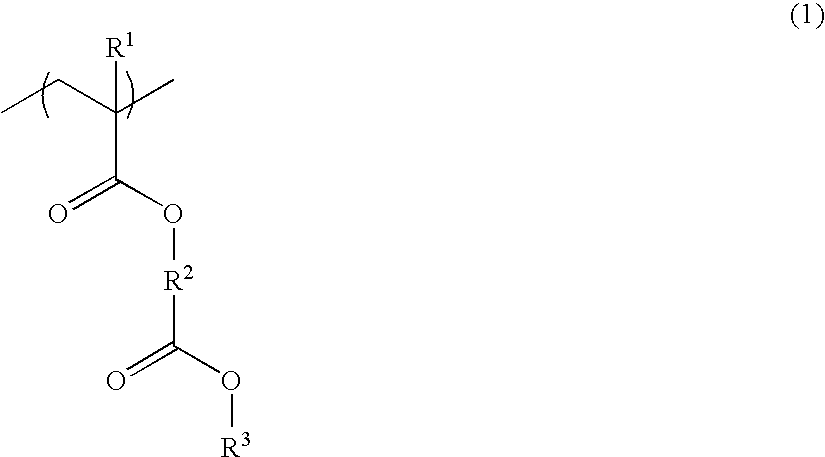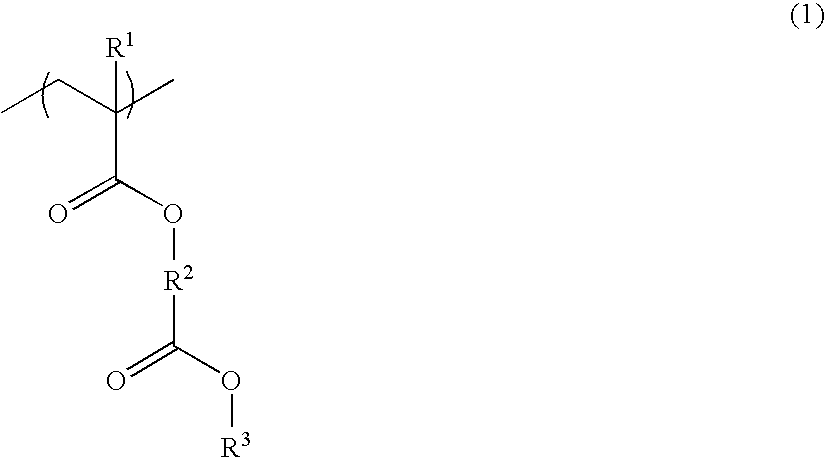Resist composition and patterning process
a composition and patterning technology, applied in the field of resist composition and patterning process, can solve the problems of resist performance, pattern profile change, postponement of fsub>2 /sub>lithography, etc., and achieve the effect of high radiation resistance, convenient handling, and convenient availability
- Summary
- Abstract
- Description
- Claims
- Application Information
AI Technical Summary
Benefits of technology
Problems solved by technology
Method used
Image
Examples
synthesis example 1
Monomer Synthesis Example 1
Synthesis of Monomer 1
[0176]
Monomer Synthesis Example 1-1
Synthesis of 2,2,2-trifluoroethyl chloroacetate
[0177]A flask was charged with 100 g of 2,2,2-trifluoroethanol, 136 g of chloroacetic acid chloride, and 500 g of acetonitrile. Below 20° C., 87 g of pyridine was added dropwise to the solution, which was stirred for 5 hours at room temperature. 200 g of water was added dropwise, followed by ordinary aqueous work-up. Distillation under atmospheric pressure gave 146 g of the end compound (yield 83%).
[0178]Boiling point: 126° C. / 101 kPa
[0179]1H-NMR (600 MHz in CDCl3):[0180]δ=4.17 (2H, s), 4.56 (2H, q) ppm
[0181]19F-NMR (565 MHz in CDCl3, trifluoroacetic acid standard):[0182]δ=−74.9 (3F, t) ppm
Monomer Synthesis Example 1-2
Synthesis of (2,2,2-trifluoroethoxycarbonyl)methyl methacrylate (Monomer 1)
[0183]Below 25° C., a mixture of 58 g of triethylamine and 50 g of dimethylformamide was added dropwise to a mixture of 51 g of methacrylic acid, 81 g of the chloroa...
synthesis example 2
Monomer Synthesis Example 2
Synthesis of Monomer 2
[0190]Synthesis was effected by the same procedure as in Monomer Synthesis Example 1-1 to 1-2 aside from using 1,1,1,3,3,3-hexafluoroisopropyl alcohol instead of 2,2,2-trifluoroethanol, obtaining (1,1,1,3,3,3-hexafluoro-isopropoxycarbonyl)methyl methacrylate (two-step yield 64%).
[0191]Boiling point: 57-58° C. / 266 Pa
[0192]IR (thin film): ν=2979, 2966, 1787, 1731, 1639, 1421, 1384, 1324, 1286, 1168, 1147, 1074, 979 cm−1
[0193]1H-NMR (600 MHz in DMSO-d6):[0194]δ=1.91 (3H, s), 5.06 (2H, s), 5.81 (1H, m), 6.13 (1H, m), 6.91 (1H, sept) ppm
[0195]19F-NMR (565 MHz in DMSO-d6, trifluoroacetic acid standard):[0196]δ=−74.6 (6F, d) ppm
synthesis example 3
Monomer Synthesis Example 3
Synthesis of Monomer 3
[0197]Synthesis was effected by the same procedure as in Monomer Synthesis Example 1-1 to 1-2 aside from using 2,2,3,3,4,4,5,5-octafluoro-1-pentanol instead of 2,2,2-trifluoroethanol, obtaining (2,2,3,3,4,4,5,5-octafluoro-1-pentyloxycarbonyl)methyl methacrylate (two-step yield 78%).
[0198]Boiling point: 81-82° C. / 40 Pa
[0199]IR (thin film): ν=2967, 1785, 1731, 1639, 1456, 1423, 1405, 1378, 1324, 1301, 1172, 1149, 1074, 948 cm−1
[0200]1H-NMR (600 MHz in DMSO-d6):[0201]δ=1.90 (3H, s), 4.88 (2H, t), 4.89 (2H, s), 5.79 (1H, m), 6.11 (1H, m), 7.05 (1H, ddd) ppm
PUM
| Property | Measurement | Unit |
|---|---|---|
| wavelength | aaaaa | aaaaa |
| wavelength | aaaaa | aaaaa |
| size | aaaaa | aaaaa |
Abstract
Description
Claims
Application Information
 Login to View More
Login to View More - R&D
- Intellectual Property
- Life Sciences
- Materials
- Tech Scout
- Unparalleled Data Quality
- Higher Quality Content
- 60% Fewer Hallucinations
Browse by: Latest US Patents, China's latest patents, Technical Efficacy Thesaurus, Application Domain, Technology Topic, Popular Technical Reports.
© 2025 PatSnap. All rights reserved.Legal|Privacy policy|Modern Slavery Act Transparency Statement|Sitemap|About US| Contact US: help@patsnap.com



